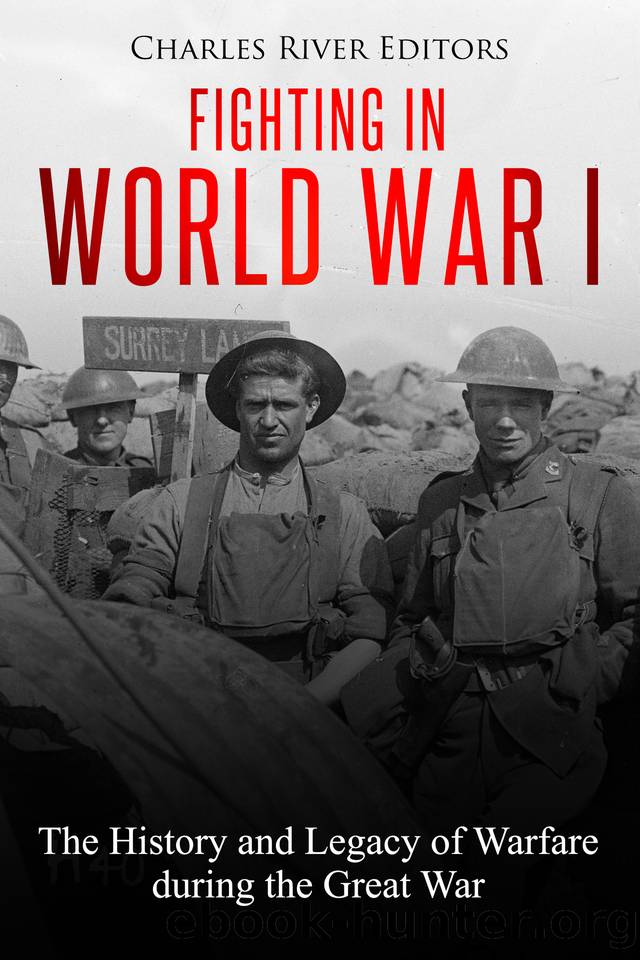Fighting in World War I: The History and Legacy of Warfare during the Great War by Charles River Editors

Author:Charles River Editors [Charles River Editors]
Language: eng
Format: epub
Publisher: Charles River Editors
Published: 2019-10-15T16:00:00+00:00
A disabled tank on the battlefield
In the middle and late months of 1917, tanks saw limited action up and down the line. Once over their surprise and shock, German troops did not hold tanks in terribly high esteem—half the time the lumbering brutes were unable to make it to their lines, and when they did, their fire was inaccurate. They could also be taken out with field guns and the occasional grenade or armor piercing round.
The watershed moment for tanks came at the Battle of Cambrai on November 20, 1917, when 474 British Tank Corps tanks, mostly Mark IVs, broke through 12 miles of the German front line, taking 10,000 prisoners, 123 artillery pieces, and 281 machine guns. The ground had been chosen well—a stretch of dry and relatively flat terrain between the Canal du Nord and the St. Quentin Canal. The attack was not preceded by the usual artillery barrage to maintain secrecy and so the ground would not be chewed up further than it already was. The tanks were supported by 1,000 guns, which gave supporting fire once the tanks had gotten underway, as well as six infantry and two cavalry divisions and 14 squadrons of the Royal Flying Corps.
The Germans were pushed out of the first three trench lines on their Hindenburg Line for the first time. Sadly for the Allies, this success was not followed through, as there was an insufficient number of infantry to hold the newly conquered ground from fierce German counterattacks and most of the gains were soon lost. Several British tanks fell into German hands, only to be studied and reused. The Allies lost 45,000 men and the Germans 50,000—men the Germans could ill afford to lose—an unusually even ratio for attackers and defenders in a war typified by defensive superiority. Germany had already been bled dry of troops, and the withdrawal to the Hindenburg Line had specifically been carried out with the aim of conserving lives.
Download
This site does not store any files on its server. We only index and link to content provided by other sites. Please contact the content providers to delete copyright contents if any and email us, we'll remove relevant links or contents immediately.
| Africa | Americas |
| Arctic & Antarctica | Asia |
| Australia & Oceania | Europe |
| Middle East | Russia |
| United States | World |
| Ancient Civilizations | Military |
| Historical Study & Educational Resources |
The Radium Girls by Kate Moore(11634)
100 Deadly Skills by Clint Emerson(4699)
The Templars by Dan Jones(4561)
Rise and Kill First by Ronen Bergman(4551)
The Doomsday Machine by Daniel Ellsberg(4252)
The Rape of Nanking by Iris Chang(4024)
Killing England by Bill O'Reilly(3900)
Hitler in Los Angeles by Steven J. Ross(3803)
Stalin by Stephen Kotkin(3731)
12 Strong by Doug Stanton(3420)
Hitler's Monsters by Eric Kurlander(3171)
Blood and Sand by Alex Von Tunzelmann(3060)
Darkest Hour by Anthony McCarten(3019)
The Code Book by Simon Singh(2868)
The Art of War Visualized by Jessica Hagy(2845)
Hitler's Flying Saucers: A Guide to German Flying Discs of the Second World War by Stevens Henry(2626)
Babylon's Ark by Lawrence Anthony(2435)
The Second World Wars by Victor Davis Hanson(2423)
Tobruk by Peter Fitzsimons(2380)
